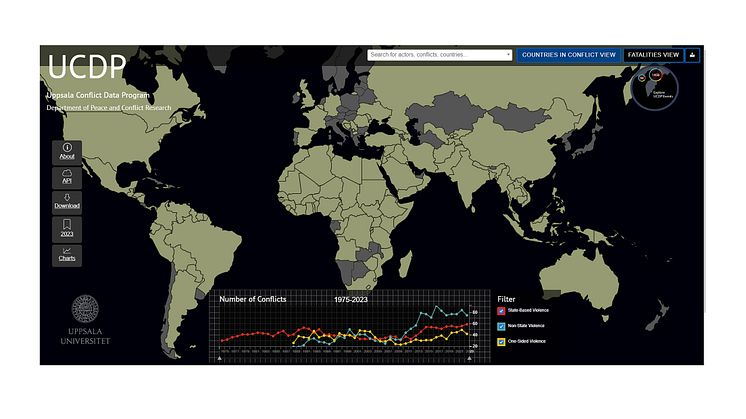
Press release -
UCDP: Sharp increase in conflicts and wars
The number of armed conflicts in the world reached a historic high in 2024. This is shown by new data from the Uppsala Conflict Data Program (UCDP) at Uppsala University. Despite a marginal decrease in total fatalities, targeted violence against civilians increased significantly.
UCDP recorded 61 active conflicts involving at least one state in 2024, up from 59 the previous year and the highest number since statistics began in 1946. Eleven of these reached the level of war, defined as a conflict causing at least 1,000 battle-related deaths in a year. This is the highest number since 2016.
Despite the sharp increase in the number of conflicts and wars, the total number of deaths decreased slightly in 2024. In total, it is estimated that nearly 160,000 people died in organised violence during the year.
“It is not that the world has become more peaceful. We see more wars and more conflicts than previously, but with slightly fewer deaths than in the exceptionally bloody year of 2022. 2024 was the fourth most violent year since the 1994 Rwandan genocide,” says Shawn Davies, Senior Analyst at UCDP.
Most deaths in Ukraine
The war in Ukraine continues to be the world’s deadliest conflict, with around 76,000 battle-related deaths in 2024. In the Middle East, Israel’s wars in Gaza and against Hezbollah in Lebanon contributed to high death rates, especially among civilians. UCDP recorded around 26,000 deaths in these two conflicts, 94 per cent of which were civilians or of unknown identity.
“It has become increasingly difficult to distinguish between civilians and members of armed groups, though the information situation has improved in many areas over the last 15 years. It is particularly challenging in situations where the line between civilian and combatant is blurred, or where indiscriminate violence such as aerial bombing is used in densely populated areas,” says Therese Pettersson, Senior Analyst at UCDP.
“In the war in Gaza, it has only been possible to classify two per cent of the dead as members of a warring party, while 48 per cent have been recorded as civilians. The rest are classified by UCDP as being of unknown identity. Reliable information on who is being killed is important for investigating suspected war crimes, for the international community to be able to act appropriately and for knowing what the needs of society will be after a conflict has ended,” Pettersson explains.
Increased violence against civilians
Violence explicitly targeting civilians increased significantly in 2024. In total, UCDP recorded 13,900 civilian deaths in this type of targeted attack, an increase of 31 per cent compared with the previous year. For the tenth consecutive year, the Islamist terrorist group IS was the deadliest actor, responsible for around 3,800 civilian fatalities, most of them in the Democratic Republic of the Congo.
A decade of conflict
Since 2010, the number of conflicts involving states has almost doubled, and the total number of deaths has increased fivefold, despite temporary declines in some years. At the same time, tensions between states have increased significantly.
“Over the past decade, we have seen an increase in the number of interstate conflicts, recording the highest number since 1987 in 2024,” says Davies. “Conflicts in which states actively support armed groups in other countries have also become more common during this period. This is a worrying trend that risks contributing to higher death rates. We live in a new era with more, and more intense and complex conflicts, which places higher demands on international conflict resolution and better protection of civilians. It is also important to continue documenting what is happening in the world’s conflicts.”
Read the full report
Davies, S., Pettersson, T., Sollenberg, M., & Öberg, M. (2025). Organized violence 1989–2024, and the challenges of identifying civilian victims. Journal of Peace Research, 0(0). DOI: 10.1177/00223433251345636
For interviews or more information:
Shawn Davies, Senior Analyst at UCDP, Department of Peace and Conflict Research at Uppsala University
Email: shawn.davies@pcr.uu.se
Phone: +46 70 404 95 09
Therese Pettersson, Senior Analyst and Project Manager at UCDP, Department of Peace and Conflict Research at Uppsala University
Email: therese.pettersson@pcr.uu.se
Phone: +46 70 649 64 91
Magnus Öberg, Senior Lecturer in Peace and Conflict Research at the Department of Peace and Conflict Research, Uppsala University
Email: magnus.oberg@pcr.uu.se
Phone: +46 70 167 90 86
About UCDP
The Uppsala Conflict Data Program (UCDP) is the world’s most widely used data source on organised violence and the oldest ongoing data collection project for civil war. The UCDP definition of armed conflict has become the global standard for the systematic definition and study of conflict.
The Uppsala Conflict Data Program (UCDP)
Find out more about the research behind The Uppsala Conflict Data Program (UCDP)
Topics
Categories
Founded in 1477, Uppsala University is the oldest university in Sweden. With more than 50,000 students and 7,500 employees in Uppsala and Visby, we are a broad university with research in social sciences, humanities, technology, natural sciences, medicine and pharmacology. Our mission is to conduct education and research of the highest quality and relevance to society on a long-term basis. Uppsala University is regularly ranked among the world’s top universities. www.uu.se




